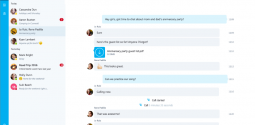15 Most Damaging Computer Viruses
- Admin
- November 21, 2016
- 1,936
While some virus attacks cause minimum threats, there are others that may lead to serious damage. In this article I have compiled a comprehensive list of the most damaging computer viruses. As people generally equate general malware such as worms and trojan horses as viruses as well, I have included them in the list as well. Here are the 15 most famous and most damaging computer viruses.
Learn also: 10 Best Photo Editor Software Programs1. Code Red
First found in 2001, Code Red was discovered by two eEye Digital Security workers. The worm targeted PCs with Microsoft IIS web server installed, exploiting a buffer overflow issue in the computer. It leaves hardly any trace on the hard disk because it is able to run completely on memory, with 3,569 bytes. Once infected, Code Red creates a hundred copies of itself. However, as a result of the programming, it will replicate even more.
2. Sasser
Discovered back in 2004, Sasser was a Windows worm first created by Sven Jaschan, a computer science student. While the payload itself may be seen as just irritating, the effects were extremely disruptive, with millions of computers being infected. These damaging computer viruses are also harmded critical infrastructure. It took advantage of a buffer overflow vulnerability in Local Security Authority Subsystem Service (LSASS) that controls the security policy of local accounts causing crashes to the computer. The effects of the virus were extensive, leading to over a million infections and taking out critical infrastructures.
3. CIH
Also known as the Chernobyl virus, CIH triggers on April 26 each year, the anniversary of the Chernobyl nuclear disaster. It overwrites a chip inside PCs paralyzing the entire system. Its author was caught by the authorities in Taiwan.
4. ILOVEYOU
This is also included in the category of the most dangerous computer viruses ever created. It managed to wreck havoc on computers across the world and damaged that totaled in at an estimate of $10 billion. It was so terrible that governments and large companies took their mailing system offline in order to remain safe from it. ILOVEYOU worked by using social engineering to get people to click on the attachment. The attachment was a script with a TXT file, due to Windows at the time hiding the actual extension of the file. Once you click it, it will send itself to all in your s mailing list and proceed to overwrite files itself, making the system unbootable.
5. Zeus
A Trojan horse designed to infect Windows systems to enable it to carry out a range of criminal tasks. Man-in-the-browser keylogging and form grabbing was the most common problem. Most PCs were infected via drive-by downloads or phishing scams. Zeus managed to compromise thousands of FTP accounts and computers from large multinational corporations and banks incluing Cisco, Amazon, Bank of America and Oracle. Controllers of these dangerous computer viruses used it to steal the login credentials of banking accounts, social network and email.
6. Stuxnet
Stuxnet is a virus designed for cyberwarfare. It was assessed that the virus managed to ruin one fifth of Iran’s nuclear centrifuges and that about 60% of infections were concentrated in Iran. It was created to attack industrial Programmable Logic Controllers (PLC), which allows for automation of courses in machinery. It aimed at those created by Siemens and was spread through infected USB drives.
7. Melissa
Created by David L. Smith in 1999, Melissa initiated as an infected Word document that was posted up on the alt.sex usenet group, asserting to be a password list for pornographic sites. When it was opened, it would trigger the macro inside and unleash its payload. These dangerous computer viruses will mail itself to the top 50 people in the user’s email address book. In turn it enhanced email traffic, disturbing the email services of governments and corporations.
8. Storm worm
The Storm worm infected computers around the world in 2007. Countless infected computers were taken over by hackers and used to spread spam and snip identities.
9. Mydoom
Mydoom was a worm for Windows that became one of the quickest spreading email worms since ILOVEYOU. ‘mydom’ was a line of text in the program’s code and sensing this was to be big, added ‘doom’ into it. It spreads itself by showing as an email transmission error and contains an attachment of itself. Once executed, it will send itself to email addresses that are in a user’s address book and copies itself to any P2P program’s folder to propagate itself through that network. Mydoom caused an estimate of $38.5 billion in damages. It is still active in some form today.
10. CryptoLocker
Targeted at PCs running windows, CryptoLocker is a form of Trojan horse ransomware. These dangerous computer viruses make use of a number of methods to spread itself including emailing. Once a system is infected, it will proceed to encrypt some files on the hard drive and any mounted storage associated with it with RSA public key cryptography. The only way to unlock the files is to pay a ransom by a certain timeline. The payoff generally amount to $400 in prepaid cash or bitcoin. The ransom operation was ultimately stopped when law enforcement agencies and security companies took control part of the botnet operating CryptoLocker and Zeus.
11. Flashback
Flashback is one of the many Mac malware to have gain infamy as it showed that Macs are not immune. The Trojan was first found in 2011. In its newer embodiment, a user simply required to have Java enabled. It propagates itself by using compromised websites with JavaScript code that will download the payload. Once installed, the Mac becomes part of a botnet of other infected Macs. It is still existing today with an estimate of 22,000 Macs still infected as of 2014.
12. The Morris worm
Back in 1998 a university student released a worm which affected 10 per cent of all the computers connected to the internet, slowing them down to a halt. The creator of this virus in working as an associate professor at MIT now.
13. Conficker
Conficker is a worm for Windows that was discovered in 2008. It infects computers using flaws in the OS to create a botnet. These dangerous computer viruses malware was able to infect over 9 million computers across the world, affecting individuals, businesses and governments. It works by exploiting a network service vulnerability that was present and unpatched in Windows. Once infected, it will reset account lockout policies, block access to Windows update and antivirus sites, turn off certain services and lock out user accounts among many.
14. The Concept virus
The first virus to infect Microsoft Word documents, The Concept virus shipped on a CD-ROM supplied by Microsoft in 1995 by accident. It became the most widespread virus the world had ever seen within no time, taking advantage of the fact that PC users shared documents via email.
15. The Anna Kournikova worm
This worm posed as a picture of the tennis player, but was in fact a virus. It was a crazy fan of Netherlands, Jan de Wit who ended up getting a community service sentence.
These most damaging computer viruses should remove from your computer; otherwise it can damage your whole system.





